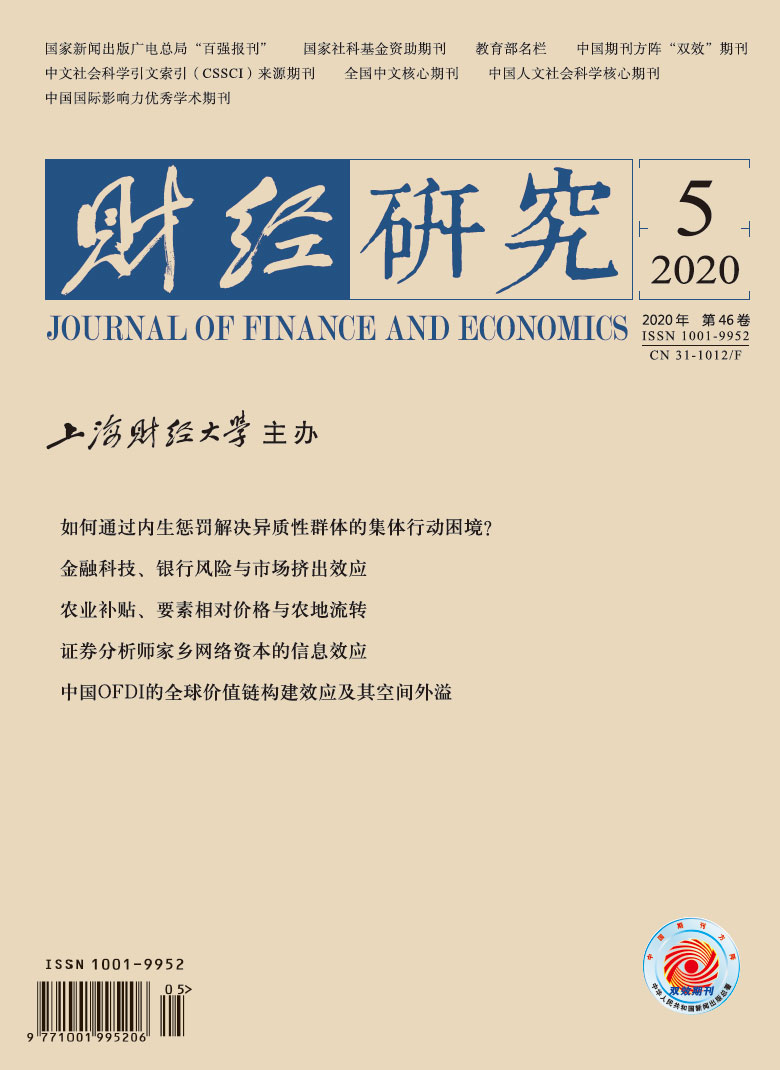[1] Gao L, Gao W H. Competition effect or scale effect—the influence of district fragmentation on the long-term economic growth of cities[J], Management World, 2018, (12): 67-80.(In Chinese)
[2] Hu J Y, Li J W, Zhang B. Does online peer-to-peer lending help to achieve inclusive finance? [J], The Journal of World Economy, 2018, (11): 169-192.(In Chinese)
[3] Jia S H, Wu B. Private contract enforcement mechanism based on reputation[J], Nankai Economic Studies, 2004, (6): 16-20.(In Chinese)
[4] Jiang S X, Luo J, Huang J C. Credit concentration and expansion, competition of soft budget constraint and systematic risk of bank [J], Journal of Financial Research, 2006, (4): 40-48.(In Chinese)
[5] Liao L, Ji L, Zhang W Q. Education and credit: Evidence from P2P lending platform[J], Journal of Financial Research, 2015, (3): 146-159.(In Chinese)
[6] Mi Y S, Liao X L, Shi X M, et al. Dynamic incentive, reputation enhancement and self-performance of interconnected loans in rural areas [J], Economic Science, 2018, (3): 102-115.(In Chinese)
[7] Aoki M. Toward a comparative institutional analysis[M], Shanghai: Shanghai Far East Press, 2001: 210-228.(In Chinese)
[8] Shen K L, Sun W J. Efficiency of investment, capital accumulation and the fluctuation of macro economy: an empirical research from the perspective of financial development [J], Social Sciences In China, 2004, (6): 52-63.(In Chinese)
[9] Wang B, Zhang X M, Lu L. Is P2P lending an effective way to realize inclusive finance——evidence from RENRENDAI.COM [J], China Industrial Economics, 2017, (2): 98-116.(In Chinese)
[10] Wang Q, Wu W, Huang J. Geographic diversification of City Commercial Banks: credit expansion, risk level and bank performance[J], Journal of Financial Research, 2012, (1):141-153.(In Chinese)
[11] Wang X. A study on internet finance helping relieve SMEs financing constraints[J], Journal of Financial Research, 2015, (9): 128-139.(In Chinese)
[12] Xie P, Zhou C W, Liu H E. The fundamental theory of internet finance[J], Journal of Financial Research, 2015, (8):1-12.(In Chinese)
[13] Yang L, Zhao C C, Chen X H. Research on credit risk mitigation mechanisms of peer-to-peer lending based on social network [J], Chinese Journal of Management Science, 2018, (1): 47-56.(In Chinese)
[14] Zhang B, Liu D, Li Y W. An empirical analysis of the determinants of farmers' loan matching from the perspective of matching economics[J], Economic Science, 2014, (4): 93-105.(In Chinese)
[15] Zhang H X, Huang Y P. Sentiment, default rate and reverse bank run—Evidence from a Chinese P2P platform [J], China Economic Quarterly, 2018, (4): 1503-1524.(In Chinese)
[16] Alchian A A, Demsetz H. Production, information costs, and economic organization[J]. IEEE Engineering Management Review, 1975, 3(2): 21−41.
[17] Ashenfelter O, Krueger A. Estimates of the economic return to schooling from a new sample of twins[J]. The American Economic Review, 1994, 84(5): 1157−1173.
[18] Balli H O, Sørensen E B. Interaction effects in econometrics[J]. Empirical Economics, 2013, 45(1): 583−603.
[19] Calvet L E, Campbell J Y, Sodini P. Measuring the financial sophistication of households[J]. The American Economic Review, 2009, 99(2): 393−398.
[20] Calvet L E, Sodini P. Twin picks: disentangling the determinants of risk-taking in household portfolios[R]. SAFE Working Paper No. 13, 2013.
[21] Chen X, Huang B H, Ye D Z. The role of punctuation in P2P lending: evidence from China[J]. Economic Modelling, 2018, 68: 634−643.
[22] Chowdhury S, Chowdhury P R, Sengupta K. Sequential lending with dynamic joint liability in micro-finance[J]. Journal of Development Economics, 2014, 111: 167−180.
[23] Christelis D, Georgarakos D, Haliassos M. Differences in portfolios across countries: economic environment versus household characteristics[J]. Review of Economics and Statistics, 2013, 95(1): 220−236.
[24] Dermine J, De Carvalho C N. Bank loan losses-given-default: a case study[J]. Journal of Banking & Finance, 2006, 30(4): 1219−1243.
[25] Diamond D W. Reputation acquisition in debt markets[J]. Journal of Political Economy, 1989, 97(4): 828−862.
[26] Emekter R, Tu Y B, Jirasakuldech B. Evaluating Credit risk and loan performance in online peer-to-peer (P2P) Lending[J]. Applied Economics, 2015, 47(1): 54−70.
[27] Harmon H, Walker I. Estimates of the economic return to schooling for the United Kingdom[J]. The American Economic Review, 1995, 85(5): 1278−1286.
[28] Herzenstein M, Sonenshein S, Dholakia U M. Tell me a good story and I may lend you money: The role of narratives in Peer-to-Peer Lending decisions[J]. Journal of Marketing Research, 2011, 48(SPL): S138−S149.
[29] Kreps D M, Milgrom P, Roberts J, et al. Rational cooperation in the finitely repeated prisoners' dilemma[J]. Journal of Economic Theory, 1982, 27(2): 245−252.
[30] Laffont J J, Rey P. Moral hazard, collusion and group lending[R]. IDEI Working Papers 122, 2003.
[31] Lichtenstein S, Fischhoff B. Do those who know more also know more about how much they know?[J]. Organizational Behavior and Human Performance, 1977, 20(2): 159−183.
[32] Mailath G J, Samuelson L. Who wants a good reputation?[J]. The Review of Economic Studies, 2001, 68(2): 415−441.
[33] Michels J. Do unverifiable disclosures matter? Evidence from peer-to-peer lending[J]. The Accounting Review, 2012, 87(4): 1385−1413.
[34] Sala-I-Martin X, Doppelhofer G, Miller R I. Determinants of long-term growth: A Bayesian averaging of classical estimates(BACE) Approach[J]. The American Economic Review, 2004, 94(4): 813−835.
[35] Stein J C. Information production and capital allocation: decentralized versus hierarchical firms[J]. The Journal of Finance, 2002, 57(5): 1891−1921.
[36] Stiglitz J E, Weiss A. Credit rationing in markets with imperfect information[J]. The American Economic Review, 1981, 71(3): 393−410.
[37] Tedeschi G A. Here today,gone tomorrow: Can dynamic incentives make microfinance more flexible?[J]. Journal of Development Economics, 2006, 80(1): 84−105.
[38] Vissing-Jorgensen A. Towards an explanation of household portfolio choice heterogeneity: nonfinancial income and participation cost structures[R]. NBER Working Papers 8884, 2002.






 5755
5755  8179
8179

